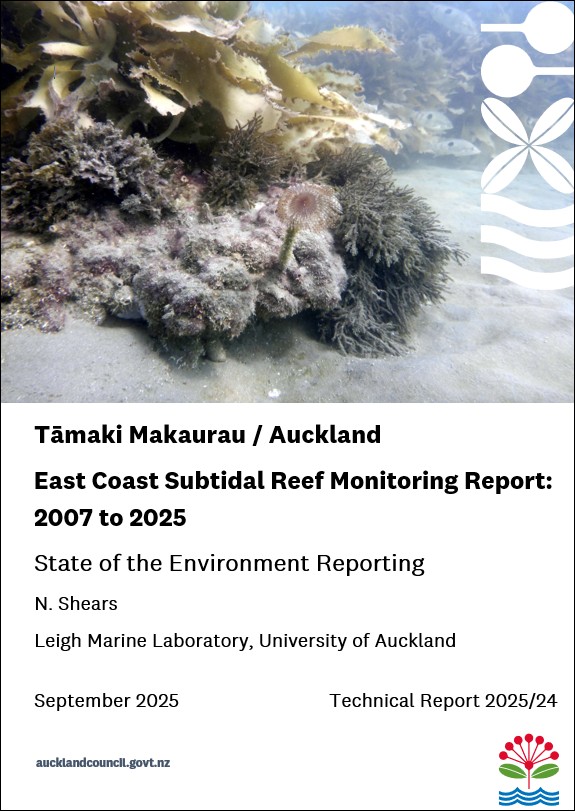Tāmaki Makaurau / Auckland east coast subtidal reef monitoring report: 2007 to 2025
Author:
Nick Shears, Leigh Marine LaboratorySource:
Auckland Council Environmental Evaluation and Monitoring Unit, EEMU | Engineering, Assets and Technical Advisory DepartmentPublication date:
2025Topics:
EnvironmentTāmaki Makaurau / Auckland east coast subtidal reef monitoring report: 2007 to 2025. State of the environment reporting
Executive summary
Subtidal rocky reefs play a critical role in Aotearoa New Zealand's coastal marine ecosystems, supporting high biodiversity and a wide variety of culturally, commercially, and recreationally important species. These reefs, often dominated by macroalgal forests, provide essential three-dimensional habitat, food, and refuge for many species. However, subtidal reef ecosystems face increasing pressure from human impacts, such as overfishing and sedimentation from land-based activities, as well as the escalating effects of climate change. By monitoring the health of subtidal rocky reefs, we can better understand how these threats impact our coastal environments and inform the strategic management of these ecosystems.
Monitoring of shallow subtidal reef sites at Meola Reef-Te Tokaroa (n=3) in the Waitematā Harbour, East Coast Bays-Whangaparāoa (ECB-WGP; n=19), and Leigh (n=4) in the outer Hauraki Gulf, has been carried out for Auckland Council since 2007. The reefs at Meola and ECB-WGP were historically characterised by dense macroalgal forests dominated by large fucoids (predominantly Carpophyllum species), with high numbers of gastropods, whereas sites at Leigh are typically dominated by the kelp Ecklonia radiata. Sampling across all 26 sites has been carried out on a biennial basis since 2019 and this report examines trends in key species and benthic covers across these locations from 2007-2025.
Across the three general areas, a number of region-wide trends were observed. This included large declines in the endemic fucoids (Carpophyllum maschalocarpum and C. flexuosum) and in total gastropod numbers (multiple species), as well as general declines in the golf ball sponge Tethya burtoni and solitary ascidians. Conversely, there has been a general increase in turfing and filamentous algae, and invasive species (e.g. Mediterranean fanworm Sabella spallanazanii), across all areas.
At Meola reef, overall macroalgal canopy cover has remained high but there has been a long-term shift from macroalgal canopies dominated by C. maschalocarpum and C. flexuosum, to the kelp E. radiata and Sargassum sinclairii. The dominant substratum covers (sediment, crustose coralline algae (CCA)) have generally remained stable, but there has been an increase in filamentous algae, red turfing algae and oysters in recent years. Increasing numbers of invasive species have been recorded in recent years including the brown seaweed Cladostephus hirsutus and the ascidians Symplegma brakenhielmi and Ascidia latesiphonica.
At ECB-WGP locations, macroalgal forest canopy cover was relatively stable until 2018/2019 after which there have been declines in canopy cover across all but two sites. This has coincided with a decline in CCA and increases in turfing algae, filamentous algae, sediment and the invasive seaweed C. hirsutus at many sites. There has also been an increase in Sargassum spp. and Cystophora retroflexa. At sites where canopies have remained intact, these are largely dominated by E. radiata and the changes in substratum covers are less evident. The invasive ascidians Styela clava, S. brakenhielmi and A. latesiphonica have established across most sites. Multi-species mortality events including Carpophyllum species, E. radiata, the small brown seaweed Zonaria turneriana, and sponges (T. burtoni), have been observed over the last five years at some sites.
At Leigh, the kelp E. radiata dominates three of the four sites and has been variable through time, which is generally related to periodic dieback events. However, at Nordic Deep there has been a general decline in kelp in recent years that does not appear to be related to dieback events. The fourth site has transitioned from urchin barrens to turfing algae over the monitoring period. In general, there has been a decline in CCA, increase in sediment, filamentous algae and turfs, and these changes in benthic covers are greatest at sites where kelp canopy is reduced.
The long-term changes over the monitoring period and particularly over the past five years are generally consistent with a transition to an unhealthier state on temperate reefs, with a reduction in canopy cover of forest-forming macroalgal species and an increase in filamentous and turfing algae, sediment cover, and invasive species at many sites. The widespread nature of these changes across the monitoring locations suggests they are regional and likely related to large-scale factors, rather than any specific local-scale or catchment-based impacts. There has been a steep increase in water temperature in the Hauraki Gulf over the monitoring period and there have been a number of unprecedented climatic events in recent years, with record-breaking marine heatwaves in 2022 and extreme storm and rainfall events in 2023. While the exact cause and mechanisms for the observed changes remain undetermined, it is likely that recent changes and observed mortality events are linked to the combined stress of these climatic events. Similar patterns are increasingly being reported on temperate reefs globally and related to increasing anthropogenic stressors and climate change. These trends are expected to continue with climate change, so ongoing monitoring is necessary to document these changes, to understand links with climate variability, and to assess potential recovery dynamics following extreme events. Targeted research is also needed to better understand causal mechanisms which can then help inform what management measures can be implemented to mitigate future impacts, increase resilience of reef communities and potentially restore these ecosystems.
Prepared by the Leigh Marine Laboratory, University of Auckland for Auckland Council
Auckland Council technical report, TR2025/24
September 2025
See also
